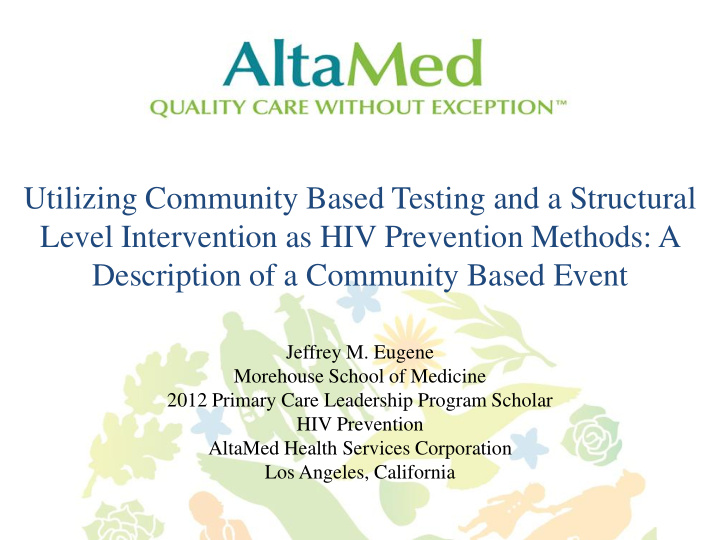



Utilizing Community Based Testing and a Structural Level Intervention as HIV Prevention Methods: A Description of a Community Based Event Jeffrey M. Eugene Morehouse School of Medicine 2012 Primary Care Leadership Program Scholar HIV Prevention AltaMed Health Services Corporation Los Angeles, California
INTRODUCTION HIV at a Glance • 1.2 million persons infected with HIV in 2008 • 48,100 new HIV infections in 2009 • Men who have sex with men (MSM) accounted for 61% of new HIV infections in 2009 • 44% of MSM newly infected with HIV were between the ages of 13-29 • MSM of color (Black or Latino) are disproportionately infected with HIV HIV in Los Angeles, California • Accounts for 46.1% of all HIV infections in CA • Latino MSM account for 93% of all new HIV infections in Latino men
INTRODUCTION, CONT Lancaster Palmdale Los Feliz Hollywood Silver Lake West Hollywood 2 5 Echo Park 101 Santa Clarita West Lake Los Angeles County 10 Downtown 10 60 Burbank 5 Sherman Oaks Pasadena 110 West Hollywood Los Angeles Pomona Cases per 2 Square Miles Santa Monica HIV/STI Cluster Areas <0.5 Whittier HIV Cases, 2009 Inglewood 0.5 - 1.7 1.8 - 3.6 1.3% 0 1 1 3.7 - 6.6 6.6% Torrance Compton 6.7 - 10.8 9.2% 10.9 - 15.2 18.4% Long Beach 15.3 - 21.8 3 46.3% 21.9 - 42.0 Los Angeles County >42.0
INTRODUCTION, CONT AltaMed’s HIV Prevention Goals • Target population: Latino MSM 18-29 • Increase HIV testing utilization • Testing goals • Linkage to care • Decreases Transmission • Seeks to reduce HIV risks through community and individual level interventions
INTRODUCTION, CONT AltaMed’s Condom Distribution Campaign • Structural-level intervention • Most effective when combined with community or individual interventions • Reduces barriers to safe sex • Normalizes and encourages condom use • Cost-effective • Message of Campaign • Plan • Distribute condoms to community organizations, clinics, and bars/clubs
OBJECTIVE 1. To plan and implement an community based testing event to kickoff AltaMed’s condom distribution campaign 2. To create a public service announcement that promotes the condom distribution campaign 3. To evaluate the effectiveness of the event in increasing HIV testing utilization and altering attitudes regarding condom use
METHODS — OBJECTIVE 1 How to Throw a Condom Release Party Step 1: Have a motivated and experienced team behind you. Step 2: Have condoms! Step 3: Set a date and identify a venue Step 4: Establish a working relationship with the owner of the venue Step 5: Identify activities to conduct at the event Step 6: Partner with a party promoter, if possible Step 7: Reserve the mobile testing unit Step 8: Communicate and be persistent! Step 9: Invite your friends! Step 10: HAVE FUN (*and use condoms)
METHODS — OBJECTIVE 2 How to Shoot a PSA Step 1: Develop a concept and tag-line Step 2: Seek advice from experts Step 3: Write a screenplay/storyboard Step 4: Have a camera Step 5: Have someone to film it and direct it Step 6: Cast Step 7: Identify locations for shooting Step 8: Get the raw footage edited, mastered, and replicated on DVD-R Step 9: Air it!
METHODS — OBJECTIVE 3 Evaluating the Event • Two Surveys • Survey 1: For unveiling event • Survey 2: For party • Variables measured by Survey 1 • Overall opinion of event • Effectiveness of PSA • Significance of condom distribution campaigns • Likelihood of using condoms • Variables measured by Survey 2: • Demographics • HIV testing behavior (When? Where?) • Condom use • Distribution of Surveys
RESULTS AND CONCLUSIONS Come be apart of the result… AltaMed’s Condom Release Event Friday, August 10, 2012 5-9p MJs Bar 2810 Hyperion Ave. Los Angeles, CA 90027 Food, Drinks, Games, Prizes, Free HIV Testing and…Condoms Galore!
ACKNOWLEDGEMENTS National Medical Fellowships (NMF) and General Electric AltaMed Health Services Corporation Dr. Michael Hochman Mr. Tom Siegmeth Ms. Natalie Sanchez HIV Prevention Team - Ken Almanza - Joaquin Gutierrez - Ramon Garcia - Angel Rosario MJs Bar Kavich Reynolds Productions
REFERENCES 1. Centers for Disease Control and Prevention (March 2012). HIV in the united states: at a glance . Retrieved August 1, 2012 from: http://www.cdc.gov/hiv/resources/factsheets/us.htm. 2. Centers for Disease Control and Prevention. (May 2012). HIV among gay and bisexual men. Retrieved August 1, 2012 from: http://www.cdc.gov/hiv/topics/msm/. 3. Centers for Disease Control and Prevention. HIV Risk, Prevention, and Testing Behaviors Among Men Who Have Sex With Men — National HIV Behavioral Surveillance System, 21 U.S. Cities, United States, 2008. MMWR 2011;60(14):1-40. 4. Centers for Disease Control and Prevention. Condom distribution as a structural level intervention. Retrieved August 1, 2012 from: http://www.cdc.gov/hiv/resources/factsheets/condom_distribution.htm. 5. HIV Epidemiology, Division of HIV and STD Programs, Los Angeles County Department of Public Health. 2011 Annual HIV Surveillance Report, February 2012: 1-36. *GIS Images courtesy of Los Angeles County Department of Public Health
QUESTIONS?
Recommend
More recommend